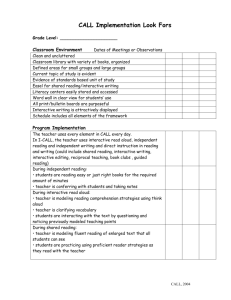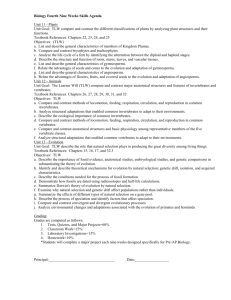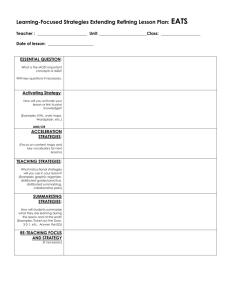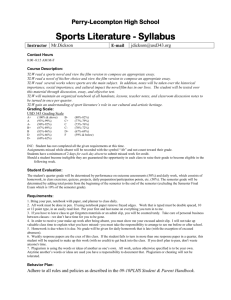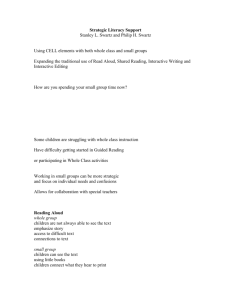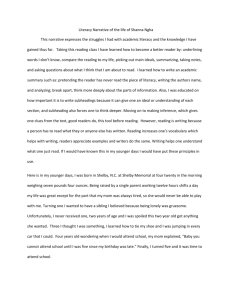Anatomy - Kent City Community Schools
advertisement
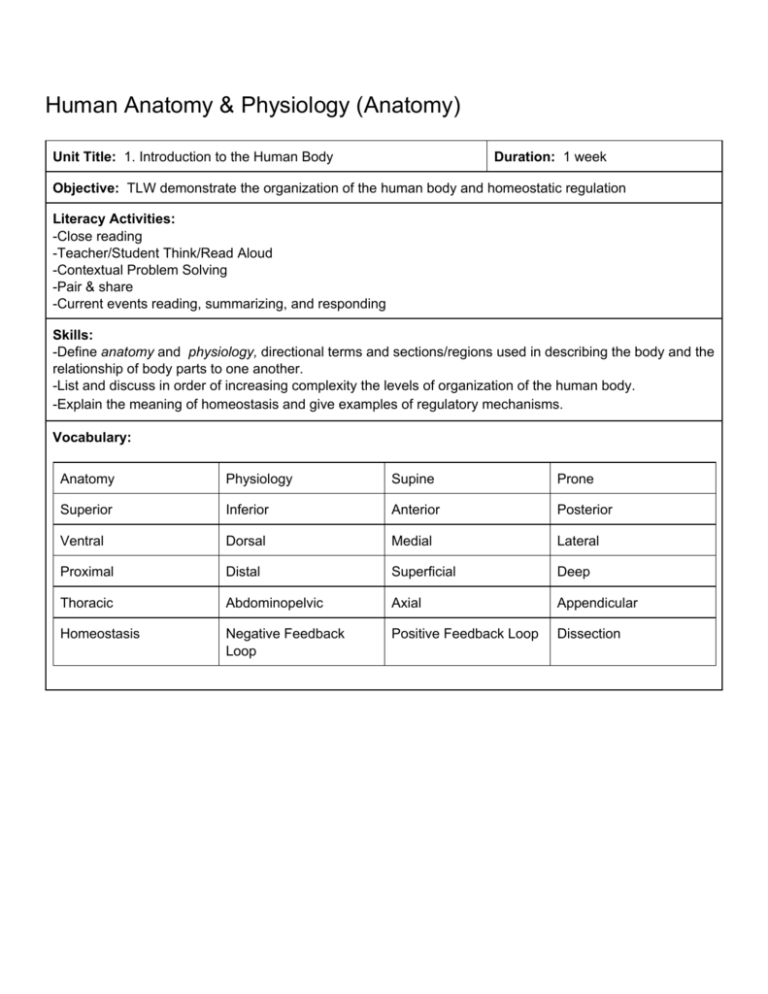
Human Anatomy & Physiology (Anatomy) Unit Title: 1. Introduction to the Human Body Duration: 1 week Objective: TLW demonstrate the organization of the human body and homeostatic regulation Literacy Activities: ­Close reading ­Teacher/Student Think/Read Aloud ­Contextual Problem Solving ­Pair & share ­Current events reading, summarizing, and responding Skills: ­Define anatomy and physiology, directional terms and sections/regions used in describing the body and the relationship of body parts to one another. ­List and discuss in order of increasing complexity the levels of organization of the human body. ­Explain the meaning of homeostasis and give examples of regulatory mechanisms. Vocabulary: Anatomy Physiology Supine Prone Superior Inferior Anterior Posterior Ventral Dorsal Medial Lateral Proximal Distal Superficial Deep Thoracic Abdominopelvic Axial Appendicular Homeostasis Negative Feedback Loop Positive Feedback Loop Dissection Unit Title: 2. Cells Duration: 3 weeks Objective: TLW understand the basic processes of cells and how they move substances across the membranes. Literacy Activities: ­Close reading ­Teacher/Student Think/Read Aloud ­Contextual Problem Solving ­Pair & share ­Current events reading, summarizing, and responding Skills: ­Identify the structural and functional parts of a cell ­Compare the major passive and active transport processes that act to move substances through cell membranes ­Compare and discuss DNA and RNA and their function in protein synthesis Vocabulary: ATP centriole cilia crenation DNA diffusion endoplasmic reticulum filtration flagellum Golgi apparatus hypertonic hypotonic lysosome nucleoplasm organelle osmosis phagocytosis pinocytosis ribosome RNA Unit Title: 3. Cell Reproduction and Tissues Duration: 3 weeks Objective: TLW identify major tissues of the body Literacy Activities: ­Close reading ­Teacher/Student Think/Read Aloud ­Contextual Problem Solving ­Pair & share ­Current events reading, summarizing, and responding Skills: ­List and discuss the 4 major types of tissues in the body. ­Identify the major types of tissue using a microscope. ­Discuss the stages of mitosis and explain the importance of cellular reproduction. Vocabulary: adipose axon chondrocyte collagen cuboidal columnar goblet cell mitosis prophase metaphase anaphase telophase neuron replication squamous transcription translation Unit Title: 4. Integumentary System Duration: 3 weeks Objective: TLW the integumentary system and its role in protecting the body. Literacy Activities: ­Close reading ­Teacher/Student Think/Read Aloud ­Pair & share ­Current events reading, summarizing, and responding Skills: ­Describe the structure and function of the epidermis and dermis ­List and briefly describe the accessory organs of the skin. ­Understand the role of the skin in protecting the body and regulating its temperature. Vocabulary: apocrine sweat gland arrector pili axon blister chondrocyte cutaneous cuticle cyanosis dermis eccrine sweat gland epidermis follicle hypodermis keratin lancuna lunula melanin mucocutaneous junction mucous membrane neuron osteocyte papilla sebaceous gland sebum serous membrane stratum corneum stratum germinativum subcutaneous sudoriferous gland synovial membrane Unit Title: 5. Skeletal System Duration: 2.5 weeks Objective: TLW identify the purpose and structure of the bones of the skeleton. Literacy Activities: ­Close reading ­Teacher/Student Think/Read Aloud ­Pair & share ­Current events reading, summarizing, and responding Skills: ­Discuss the functions of the skeletal system. ­Identify the major anatomical structures found in a typical long bone. ­List the bones found in the main subdivisions of the skeleton. ­Compare the major types of joints. Vocabulary: appendicular skeleton articular cartilage articulation axial skeleton chondrocytes compact bone diaphysis epiphysis fontanels hemopoiesis osteoblasts osteoclasts osteocytes pectoral girdle pelvic girdle red bone marrow sinus synovial membrane yellow bone marrow Unit Title: 6. Muscular System Duration: 2.5 weeks Objective: TLW identify muscle structure and understand contraction and effects of exercise Literacy Activities: ­Close reading ­Teacher/Student Think/Read Aloud ­Contextual Problem Solving ­Pair & share ­Current events reading, summarizing, and responding Skills: ­Locate and compare the structure and function of the three major types of muscle tissue. ­Discuss the microscopic structure of a skeletal muscle sarcomere and motor unit and how contraction occurs. ­Identify and give the function of the major muscle groups. ­Isolate and identify muscles of a rat. Vocabulary: abduction actin adduction all or none antagonist atrophy bursa extension fatigue flexion hypertrophy hypothermia insertion isometric isotonic motor neuron myofilaments myosin neuromuscular junction origin oxygen debt paralysis prime mover sarcomere synergist tendon tetanic contraction tonic contraction Unit Title: 7. Digestive System Duration: 2.5 weeks Objective: TLW understand the purpose and parts of the digestive system. Literacy Activities: ­Close reading ­Teacher/Student Think/Read Aloud ­Group reading ­Pair & share ­Current events reading, summarizing, and responding Skills: ­List in sequence each of the component parts or segments of the alimentary canal. ­Identify accessory organs of digestion. ­Define and contrast mechanical and chemical digestion and note where they take place. ­Discuss the basics of protein, lipid, and carbohydrate digestion. ­Dissect and identify internal organs of rats. Vocabulary: absorption alimentary canal appendicitis bolus chyme constipation diarrhea digestion emulsify feces frenulum gastroesophageal reflux jaundice mastication mesentery papilla peristalsis rugae ulcer uvula villus Unit Title: 8. Nutrition Duration: 2 weeks Objective: TLW describe metabolic roles of the major nutrient groups. Literacy Activities: ­Close reading ­Teacher/Student Think/Read Aloud ­Pair & share ­Current events reading, summarizing, and responding Skill: ­Define and contrast anabolism and catabolism ­Describe the metabolic roles of carbohydrates, lipids, proteins, vitamins, and minerals ­Define basal metabolic rate and list factors that affect it ­Track and classify food intake for one week Vocabulary: Duration: 3 weeks Unit Title: 9. Rat dissection Objective: TLW identify major muscle groups, internal organs, and blood vessels of the rat. Literacy Activities: ­Close reading ­Teacher/Student Think/Read Aloud ­Pair & share ­Current events reading, summarizing, and responding Skills: ­Identify external anatomy before skinning the rat ­Isolate and identify major muscles ­Identify internal body organs ­Isolate and identify major blood vessels Vocabulary: aorta biceps brachii brachialis carotid artery cortex external oblique femoral artery/vein gastrocnemius gluteus muscles iliac artery/vein intercostals internal oblique masseter medulla pectoralis muscle pinna rectus abdominus rectus femoris renal artery/vein semitendonosis subclavian artery/vein triceps brachii ureter urethra vena cava Unit Title: 10. Blood Duration: 1.5 weeks Objective: TLW describe the components of blood and their function as well as compatibility of donations. Literacy Activities: ­Close reading ­Teacher/Student Think/Read Aloud ­Pair & share ­Current events reading, summarizing, and responding Skills: ­Describe the primary functions and formed elements of blood ­Explain the steps in blood clotting ­Describe ABO and Rh blood typing Vocabulary: anemia antibodies antigens embolus erythroblastosis fetalis erythrocyte fibrin fibrinogen hematocrit hemoglobin heparin leukemia leukocyte leukocytosis lymphocyte oxyhemoglobin phagocyte plasma polycythemia serum thrombocyte thrombus Unit Title: 11. Circulatory & Lymphatic Systems Duration: 2 weeks Objective: TLW understand how blood circulates through the heart and blood vessels. TLW also understand the importance of the fluids of the cardiovascular and lymphatic systems. Literacy Activities: ­Close reading ­Teacher/Student Think/Read Aloud ­Pair & share ­Current events reading, summarizing, and responding Skills: ­Identify the heart chambers, sounds, and valves ­Trace blood through the heart and body ­Explain the relationship between blood vessel structure and function ­Use a sphygmomanometer to take blood pressure and know the primary factors involved in its generation ­Identify major organs of the lymphatic system ­Compare and contrast the major types of immunity Vocabulary: angina arteriole artery AV valve atrium bicuspid valve capillary cardiac output CPR coronary bypass surgery diastolic pressure ECG endocardium myocardial infarction myocardium pacemaker pericardium pulse tricuspid valve vein ventricle venule Duration: 2 weeks Unit Title: 12. Respiratory System Objective: TLW comprehend breathing and the organs through which air passes Literacy Activities: ­Close reading ­Teacher/Student Think/Read Aloud ­Pair & share ­Current events reading, summarizing, and responding Skills: ­List the major organs of the respiratory system and describe their functions ­Compare and contrast inhalation and exhalation ­Discuss the volumes of air exchanged during pulmonary ventilation ­Use spirometers to determine vital capacity Vocabulary: alveoli apnea bronchi ERV Heimlich maneuver hyperventilation IRV larynx oxyhemoglobin pharynx pulmonary ventilation RV respiration spirometer TV trachea VC Duration: 1 weeks Unit Title: 13. Urinary system Objective: TLW recognize the functions of the urinary organs and factors that influence urine production Literacy Activities: ­Close reading ­Teacher/Student Think/Read Aloud ­Pair & share ­Current events reading, summarizing, and responding Skills: ­Identify the organs of the urinary system and give the generalized function of each ­Name the parts of a nephron and describe their role in urine formation ­List factors that influence urine volume ­Discuss avenues by which water enters and leaves the body on a regular basis ­Identify normal vs irregular urine samples Vocabulary: cystitis diuretic edema incontinence interstitial fluid micturition polyuria renal ureter urethra voiding Unit Title: 14. Nervous System and Special Senses Duration: 2 weeks Objective: TLW understand how impulses are sent through the nervous system and how special sense organs contribute to the overall body’s function Literacy Activities: ­Close reading ­Teacher/Student Think/Read Aloud ­Pair & share ­Current events reading, summarizing, and responding Skills: ­List the organs and divisions of the nervous system ­Discuss how nerve impulses are sent ­Identify the major components of the brain ­Describe the structure of the eye and functions of its component ­Identify the ear’s anatomy and its sensory function in hearing and equilibrium ­Discuss chemoreceptors in the nose and tongue Vocabulary: Duration: weeks Unit Title: 1 Objective: TLW Literacy Activities: ­Close reading ­Teacher/Student Think/Read Aloud ­Pair & share ­Current events reading, summarizing, and responding Skills: ­ Vocabulary:
